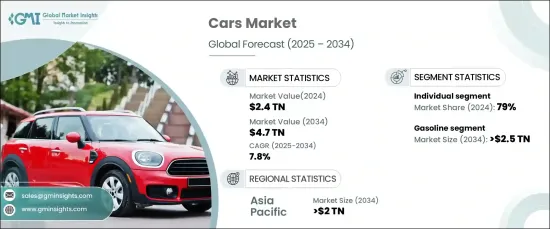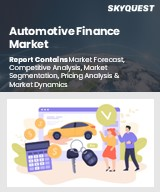
|
시장보고서
상품코드
1666907
자동차 시장 기회, 성장 촉진요인, 산업 동향 분석, 예측(2025-2034년)Cars Market Opportunity, Growth Drivers, Industry Trend Analysis, and Forecast 2025 - 2034 |
||||||
세계 자동차 시장은 2024년 2조 4,000억 달러 규모로 2025년부터 2034년까지 CAGR 7.8%로 확대될 것으로 예상되며, 큰 폭의 성장이 예상됩니다.
이러한 급격한 성장의 배경에는 세계 인구 증가, 급속한 도시화, 개인 이동수단에 대한 수요 증가 등 여러 가지 요인이 있습니다. 도시가 계속 확장되고 도시로 이주하는 사람들이 늘어남에 따라 출퇴근 시간이 길어짐에 따라 소비자들이 자가용을 이용하게 되었습니다. 자동차는 유연성과 교통 체증을 극복할 수 있는 능력으로 인해 편안함과 실용성을 모두 제공하기 때문에 빠르게 선호되는 교통수단이 되고 있습니다. 또한, 가처분 소득의 급격한 증가는 고가 자동차에 대한 수요 확대에 기여하고 있습니다. 구매력 상승에 따라 소비자의 관심은 더 높은 편의성, 더 높은 편안함, 개성 있는 기능을 제공하는 자동차에 집중되고 있습니다. 이러한 소비자의 취향은 고급차부터 최첨단 기술을 탑재한 차량까지 다양한 차종에 대한 수요를 불러일으키며 자동차 시장의 성장을 더욱 촉진하고 있습니다.

추진력 유형에 따라 시장은 가솔린차, 디젤차, 전기자동차, 연료전지전기자동차(FCEV)로 구분됩니다. 현재 가솔린 차량이 시장을 지배하고 있으며, 2024년 시장 점유율은 가솔린 차량이 55%를 차지했습니다. 이 부문은 2034년까지 2조 5,000억 달러 규모의 시장을 창출할 것으로 예상됩니다. 가솔린 차량은 전기자동차와 하이브리드 차량의 꾸준한 성장에도 불구하고, 폭넓은 가용성과 신뢰성으로 인해 여전히 가장 인기 있는 선택으로 남아 있습니다. 주유 인프라가 잘 갖춰진 지역에서는 여전히 가솔린 차량이 선호되고 있으며, 세계 자동차 시장에서 중요한 역할을 하고 있습니다.
| 시장 범위 | |
|---|---|
| 시작 연도 | 2024년 |
| 예측 연도 | 2025-2034년 |
| 시작 금액 | 2조 4,000억 달러 |
| 예상 금액 | 4조 7,000억 달러 |
| CAGR | 7.8% |
최종 용도별로 시장은 상업용 부문과 개인용 부문으로 나뉩니다. 개인용 부문은 2024년 시장 점유율의 79%를 차지했으며, 변화하는 근무 형태와 안전과 편의성에 대한 관심 증가가 그 원동력이 될 것으로 보입니다. 개인의 취향과 기호에 맞는 맞춤형 운송 솔루션에 대한 수요가 증가함에 따라, 맞춤형 기능부터 미적 개선에 이르기까지 다양한 차량 커스터마이징 옵션을 원하는 소비자가 증가하고 있습니다.
지역별로는 아시아태평양이 2024년 세계 자동차 시장에서 45%의 압도적인 점유율을 차지하며 2034년까지 2조 달러를 창출할 것으로 예상됩니다. 특히 중국은 이러한 성장의 최전선에 있습니다. 중국은 높은 수준의 제조 능력을 보유하고 있으며, 기존 자동차와 전기자동차 모두에 대한 소비자 수요가 강합니다. 중국의 자동차 시장은 친환경 에너지 솔루션의 채택을 장려하고 기술 혁신을 촉진하는 정부 인센티브에 힘입어 세계 자동차 산업을 선도하고 있습니다.
목차
제1장 조사 방법과 조사 범위
- 조사 설계
- 조사 접근법
- 데이터 수집 방법
- 기본 추정과 계산
- 기준 연도 산출
- 시장 추정의 주요 동향
- 예측 모델
- 1차 조사와 검증
- 1차 정보
- 데이터 마이닝 소스
- 시장 정의
제2장 주요 요약
제3장 업계 인사이트
- 생태계 분석
- 공급업체 상황
- 원자재 공급업체
- 부품 제조업체
- 티어 1공급업체
- 주문자상표부착생산(OEM)
- 딜러
- 이익률 분석
- 비용 내역과 가격 분석
- 테크놀러지와 혁신 전망
- 주요 뉴스와 대처
- 규제 상황
- 영향요인
- 성장 촉진요인
- 세계 인구 증가와 도시화
- 기술 진보 증가
- 가처분 소득 증가
- 신흥 시장의 중간층 인구 증가
- 업계의 잠재적 리스크와 과제
- 세계·공급망 문제
- 비용 상승 우려
- 성장 촉진요인
- 성장 가능성 분석
- Porters 분석
- PESTEL 분석
제4장 경쟁 구도
- 소개
- 기업 점유율 분석
- 경쟁 포지셔닝 매트릭스
- 전략 전망 매트릭스
제5장 시장 추정과 예측 : 자동차별, 2021-2034년
- 주요 동향
- 해치백
- 세단
- SUV
- 스포츠카
- 기타
제6장 시장 추정과 예측 : 추진력별, 2021-2034년
- 주요 동향
- 가솔린
- 디젤
- 전기
- FCEV
제7장 시장 추정과 예측 : 최종 용도별, 2021-2034년
- 주요 동향
- 상업
- 라이드셰어링과 택시 서비스
- 렌터카 서비스
- 법인용 차량
- 개인용
제8장 시장 추정과 예측 : 판매 채널별, 2021-2034년
- 주요 동향
- P2P(Peer-to-Peer)
- 프랜차이즈 딜러
- 독립 딜러
제9장 시장 추정과 예측 : 지역별, 2021-2034년
- 주요 동향
- 북미
- 미국
- 캐나다
- 유럽
- 영국
- 독일
- 프랑스
- 스페인
- 이탈리아
- 러시아
- 북유럽
- 아시아태평양
- 중국
- 인도
- 일본
- 한국
- 뉴질랜드
- 동남아시아
- 라틴아메리카
- 브라질
- 멕시코
- 아르헨티나
- 중동 및 아프리카
- UAE
- 남아프리카공화국
- 사우디아라비아
제10장 기업 개요
- BMW
- Daimler
- Fiat Chrysler Automobiles
- Ford Motor
- Geely
- General Motors
- Honda Motor
- Hyundai Motor
- Kia
- Mazda Motor
- Nissan
- PSA Group
- Renault Group
- SAIC
- Stellantis
- Suzuki Motor
- Tata Motors
- Tesla
- Toyota Motor
- Volkswagen Group
The Global Cars Market is valued at USD 2.4 trillion in 2024, and it is poised for substantial growth, expected to expand at a CAGR of 7.8% from 2025 to 2034. This rapid growth is fueled by several factors, including rising global population levels, rapid urbanization, and the growing demand for personal transportation. As cities continue to expand and more people relocate to urban areas, longer commutes are pushing consumers toward private vehicles. Cars are quickly becoming the preferred mode of transport due to their flexibility and ability to navigate through traffic, offering both comfort and practicality. Additionally, the surge in disposable incomes is contributing to the growing demand for high-value automobiles. With purchasing power on the rise, consumers are shifting their focus toward vehicles that offer greater convenience, enhanced comfort, and personalized features. This consumer preference is fueling the demand for a wide variety of car models, from luxury vehicles to cars equipped with cutting-edge technology, thus further driving growth in the automotive market.

The market is segmented by propulsion type into gasoline, diesel, electric, and fuel cell electric vehicles (FCEV). Gasoline-powered vehicles currently dominate the market, with the gasoline segment holding 55% market share in 2024. This segment is expected to generate USD 2.5 trillion by 2034. Gasoline cars continue to be the most popular choice due to their broad availability and reliability, despite the steady rise of electric and hybrid vehicles. Areas with well-established refueling infrastructure still favor gasoline-powered vehicles, ensuring that they remain a significant player in the global automotive market.
| Market Scope | |
|---|---|
| Start Year | 2024 |
| Forecast Year | 2025-2034 |
| Start Value | $2.4 Trillion |
| Forecast Value | $4.7 Trillion |
| CAGR | 7.8% |
By end-use, the market is divided into commercial and individual segments. The individual segment accounted for 79% of the market share in 2024, driven by evolving work patterns and a growing focus on safety and convenience. More and more consumers are seeking customization options for their vehicles, from tailored features to aesthetic enhancements, reflecting the increasing demand for personalized transportation solutions that cater to individual tastes and preferences.
In terms of regional markets, Asia Pacific holds a dominant 45% share of the global cars market in 2024 and is expected to generate USD 2 trillion by 2034. China, in particular, is at the forefront of this growth. The country boasts advanced manufacturing capabilities and a strong consumer demand for both traditional and electric vehicles. China's automotive market is further supported by government incentives that encourage the adoption of green energy solutions and foster technological innovation, positioning the country as a leading force in the global automotive industry.
Table of Contents
Chapter 1 Methodology & Scope
- 1.1 Research design
- 1.1.1 Research approach
- 1.1.2 Data collection methods
- 1.2 Base estimates and calculations
- 1.2.1 Base year calculation
- 1.2.2 Key trends for market estimates
- 1.3 Forecast model
- 1.4 Primary research & validation
- 1.4.1 Primary sources
- 1.4.2 Data mining sources
- 1.5 Market definitions
Chapter 2 Executive Summary
- 2.1 Industry 3600 synopsis, 2021 - 2034
Chapter 3 Industry Insights
- 3.1 Industry ecosystem analysis
- 3.2 Supplier landscape
- 3.2.1 Raw material suppliers
- 3.2.2 Component manufacturers
- 3.2.3 Tier-1 suppliers
- 3.2.4 Original Equipment Manufacturers(OEMs)
- 3.2.5 Dealerships
- 3.3 Profit margin analysis
- 3.4 Cost breakdown and price analysis
- 3.5 Technology & innovation landscape
- 3.6 Key news & initiatives
- 3.7 Regulatory landscape
- 3.8 Impact forces
- 3.8.1 Growth drivers
- 3.8.1.1 Growing global population and urbanization
- 3.8.1.2 Increasing technological advancements
- 3.8.1.3 Rising disposable incomes
- 3.8.1.4 Growing middle-class population in the emerging markets
- 3.8.2 Industry pitfalls & challenges
- 3.8.2.1 Global supply chain issues
- 3.8.2.2 Rising cost concerns
- 3.8.1 Growth drivers
- 3.9 Growth potential analysis
- 3.10 Porter’s analysis
- 3.11 PESTEL analysis
Chapter 4 Competitive Landscape, 2024
- 4.1 Introduction
- 4.2 Company market share analysis
- 4.3 Competitive positioning matrix
- 4.4 Strategic outlook matrix
Chapter 5 Market Estimates & Forecast, By Vehicle, 2021 - 2034 ($Bn, Units)
- 5.1 Key trends
- 5.2 Hatchback
- 5.3 Sedan
- 5.4 SUV
- 5.5 Sports car
- 5.6 Others
Chapter 6 Market Estimates & Forecast, By Propulsion, 2021 - 2034 ($Bn, Units)
- 6.1 Key trends
- 6.2 Gasoline
- 6.3 Diesel
- 6.4 Electric
- 6.5 FCEV
Chapter 7 Market Estimates & Forecast, By End Use, 2021 - 2034 ($Bn, Units)
- 7.1 Key trends
- 7.2 Commercial
- 7.2.1 Ridesharing and taxi services
- 7.2.2 Rental car services
- 7.2.3 Corporate fleet
- 7.3 Individual
Chapter 8 Market Estimates & Forecast, By Sales Channel, 2021 - 2034 ($Bn, Units)
- 8.1 Key trends
- 8.2 Peer-to-peer
- 8.3 Franchised dealer
- 8.4 Independent dealer
Chapter 9 Market Estimates & Forecast, By Region, 2021 - 2034 ($Bn, Units)
- 9.1 Key trends
- 9.2 North America
- 9.2.1 U.S.
- 9.2.2 Canada
- 9.3 Europe
- 9.3.1 UK
- 9.3.2 Germany
- 9.3.3 France
- 9.3.4 Spain
- 9.3.5 Italy
- 9.3.6 Russia
- 9.3.7 Nordics
- 9.4 Asia Pacific
- 9.4.1 China
- 9.4.2 India
- 9.4.3 Japan
- 9.4.4 South Korea
- 9.4.5 ANZ
- 9.4.6 Southeast Asia
- 9.5 Latin America
- 9.5.1 Brazil
- 9.5.2 Mexico
- 9.5.3 Argentina
- 9.6 MEA
- 9.6.1 UAE
- 9.6.2 South Africa
- 9.6.3 Saudi Arabia
Chapter 10 Company Profiles
- 10.1 BMW
- 10.2 Daimler
- 10.3 Fiat Chrysler Automobiles
- 10.4 Ford Motor
- 10.5 Geely
- 10.6 General Motors
- 10.7 Honda Motor
- 10.8 Hyundai Motor
- 10.9 Kia
- 10.10 Mazda Motor
- 10.11 Nissan
- 10.12 PSA Group
- 10.13 Renault Group
- 10.14 SAIC
- 10.15 Stellantis
- 10.16 Suzuki Motor
- 10.17 Tata Motors
- 10.18 Tesla
- 10.19 Toyota Motor
- 10.20 Volkswagen Group



















